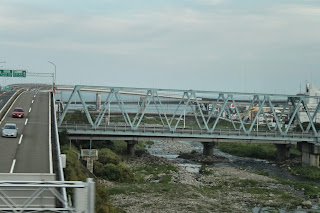We started off the day in Shingu with a lecture at the City Hall. We were welcomed by the entire staff, which is a very humbling experience. They had provided an interpreter, who traveled with us on site visits afterwards in the bus. We saw the results of many landslides along the river, which was also one of the few geographical locations where roads could be built. An unnecessary amount of landslide pictures resulted. One of the sites we visited included temporary housing units built on a mountain slope as opposed to the flooded valley.
After returning to Shingu, we visited the famous local
shrine, and following that we met up with an MLIT officer who explained about the dam built in a side branch of the
Kumano river. This dam is to prevent flood water from flowing up the side branch, called Onodani river. We then proceeded to have a bus trip up the Onodani to see the flood protection measures for the houses in the valley. Different types of flood walls have been installed, including a castle like structure which allows inhabitants to see the actual water levels through the glass. Other areas still show the intelligence of living only in the higher areas. The harvest season had just begun.
After another voluptuous amount of pictures of the countryside, we arrived back at Shingu city and set off to our final destination, Ise, passing along the same route we traveled yesterday. The Japanese coastline is mostly rocky, littered with small stones rather than fine sand. And 'sea melons'. We found the area was famous for mikan, mandarins.

























